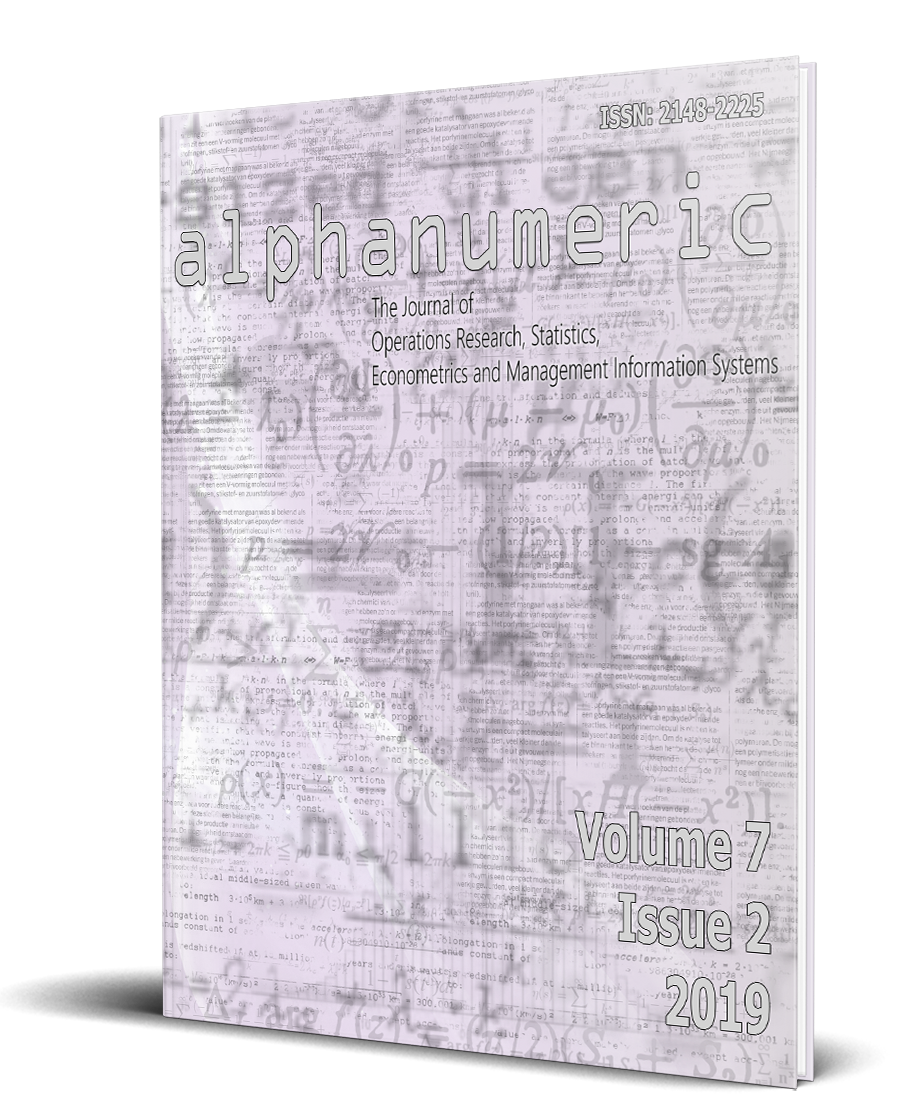
alphanumeric journal
The Journal of Operations Research, Statistics, Econometrics and Management Information Systems
Classification of Historical Anatolian Coins with Machine Learning Algorithms
Abstract
To find out which period the historical coins belong to requires a number of scientific procedures that archaeologists or experts can do. These operations can often be time-consuming and demanding operations. From this point on, in this study, the automatically classification of historical coins by using machine learning methods is discussed. Being able to use machine learning methods to classify historical coins can help experts and can become an analysis tool without the need for scientific tests for non-experts. For this purpose, some physical properties of different coins used in Anatolian geography were collected and classified by various machine learning methods named SVM, Random Forest, Bagging, and Decision Trees. Also, two different missing values strategies are deployed in conjunction with each chosen method. Based on our findings, random forest method together with imputing missing values with mean gives an acceptable results with the accuracy rate of %71, although there are some limitations such as high rate of missing values and working with a small dataset.
Keywords: Bagging, Classification, Decision Trees, Historical Coins, Machine Learning, Random Forest, Support Vector Machine
Jel Classification: C63
Suggested citation
(). Classification of Historical Anatolian Coins with Machine Learning Algorithms. Alphanumeric Journal, 7(2), 275-288. http://dx.doi.org/10.17093/alphanumeric.620095
References
- Baker, R. (2010). Data mining for education. International Encyclopedia of Education, 7(3), 112–118.
- Bose, I., & Mahapatra, R. K. (2001). Business data mining—a machine learning perspective. Information & Management, 39(3), 211–225.
- Breiman, L. (1996). Bagging predictors. Machine Learning, 24(2), 123–140.
- Breiman, L. (2001). Random forests. Machine Learning, 45(1), 5–32.
- Collobert, R., Weston, J., Bottou, L., Karlen, M., Kavukcuoglu, K., & Kuksa, P. (2011). Natural language processing (almost) from scratch. Journal of Machine Learning Research, 12(Aug), 2493–2537.
- Cortes, C., & Vapnik, V. (1995). Support-vector networks. Machine Learning, 20(3), 273–297.
- Davidsson, P. (1997). Coin classification using a novel technique for learning characteristic decision trees by controlling the degree of generalization. In Ninth International Conference on Industrial & Engineering Applications of Artificial Intelligence & Expert Systems (pp. 403–412).
- Deo, R. C. (2015). Machine learning in medicine. Circulation, 132(20), 1920–1930.
- Drucker, H., Burges, C. J. C., Kaufman, L., Smola, A. J., & Vapnik, V. (1997). Support vector regression machines. In Advances in neural information processing systems (pp. 155–161).
- Feldman, R., & Sanger, J. (2007). The text mining handbook: advanced approaches in analyzing unstructured data. Cambridge university press.
- Fukumi, M., Omatu, S., Takeda, F., & Kosaka, T. (1992). Rotation-invariant neural pattern recognition system with application to coin recognition. IEEE Transactions on Neural Networks, 3(2), 272–279.
- Huber, R., Ramoser, H., Mayer, K., Penz, H., & Rubik, M. (2005). Classification of coins using an eigenspace approach. Pattern Recognition Letters, 26(1), 61–75.
- Long, J., Shelhamer, E., & Darrell, T. (2015). Fully convolutional networks for semantic segmentation. In Proceedings of the IEEE conference on computer vision and pattern recognition (pp. 3431–3440).
- Michels, J. W. (1973). Dating methods in archaeology.
- Nölle, M., Penz, H., Rubik, M., Mayer, K., Holländer, I., & Granec, R. (2003). Dagobert-a new coin recognition and sorting system. In Proceedings of the 7th Internation Conference on Digital Image Computing-Techniques and Applications (DICTA’03), Syndney, Australia.
- Nölle, M., Rubik, M., & Hanbury, A. (2006). Results of the muscle cis coin competition 2006. In Proceedings of the Muscle CIS Coin Competition Workshop, Berlin, Germany (pp. 1–5). Citeseer.
- Obermeyer, Z., & Emanuel, E. J. (2016). Predicting the future—big data, machine learning, and clinical medicine. The New England Journal of Medicine, 375(13), 1216.
- Priore, P., De La Fuente, D., Gomez, A., & Puente, J. (2001). A review of machine learning in dynamic scheduling of flexible manufacturing systems. Ai Edam, 15(3), 251–263.
- Quinlan, J. R. (1986). Induction of decision trees. Machine Learning, 1(1), 81–106.
- Reisert, M., Ronneberger, O., & Burkhardt, H. (2006). An efficient gradient based registration technique for coin recognition. In Proc. of the Muscle CIS Coin Competition Workshop, Berlin, Germany (pp. 19–31).
- Sallab, A. E. L., Abdou, M., Perot, E., & Yogamani, S. (2017). Deep reinforcement learning framework for autonomous driving. Electronic Imaging, 2017(19), 70–76.
- Trippi, R. R., By-Lee, P., & Jae, K. (1995). Artificial intelligence in finance and investing: state-of-the-art technologies for securities selection and portfolio management. McGraw-Hill, Inc.
- Van Der Maaten, L. J., & Poon, P. (2006). Coin-o-matic: A fast system for reliable coin classification. In Proc. of the Muscle CIS Coin Competition Workshop, Berlin, Germany (pp. 7–18).
- Van Der Maaten, L., & Postma, E. (2006). Towards automatic coin classification. na.
- Wuest, T., Weimer, D., Irgens, C., & Thoben, K.-D. (2016). Machine learning in manufacturing: advantages, challenges, and applications. Production & Manufacturing Research, 4(1), 23–45.
- Zambanini, S., & Kampel, M. (2011). Automatic coin classification by image matching. In Proceedings of the 12th International conference on Virtual Reality, Archaeology and Cultural Heritage (pp. 65–72). Eurographics Association.
- Zhu, X. (2015). Machine teaching: An inverse problem to machine learning and an approach toward optimal education. In Twenty-Ninth AAAI Conference on Artificial Intelligence.
2019.07.02.MIS.02
alphanumeric journal
Pages 275-288
Received: Sept. 13, 2019
Accepted: Dec. 28, 2019
Published: Dec. 31, 2019
2019 Ünlü, R.
This is an Open Access article, licensed under Creative Commons Attribution-NonCommercial 4.0 International License.

scan QR code to access this article from your mobile device
Contact Us
Faculty of Transportation and Logistics, Istanbul University
Beyazit
Campus 34452 Fatih/Istanbul/Türkiye
Bahadır Fatih Yıldırım, Ph.D.
editor@alphanumericjournal.com
+ 90
(212) 440 00 00 - 13219
alphanumeric journal
alphanumeric journal has been publishing as "International Peer-Reviewed Journal" every six months since 2013. alphanumeric serves as a vehicle for researchers and practitioners in the field of quantitative methods, and is enabling a process of sharing in all fields related to the operations research, statistics, econometrics and management informations systems in order to enhance the quality on a globe scale.

